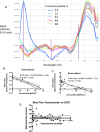Accuracy of detection of carboxyhemoglobin and methemoglobin in human and bovine blood with an inexpensive, pocket-size infrared scanner
- PMID: 29513738
- PMCID: PMC5841812
- DOI: 10.1371/journal.pone.0193891
Accuracy of detection of carboxyhemoglobin and methemoglobin in human and bovine blood with an inexpensive, pocket-size infrared scanner
Abstract
Detecting life-threatening common dyshemoglobins such as carboxyhemoglobin (COHb, resulting from carbon monoxide poisoning) or methemoglobin (MetHb, caused by exposure to nitrates) typically requires a laboratory CO-oximeter. Because of cost, these spectrophotometer-based instrument are often inaccessible in resource-poor settings. The aim of this study was to determine if an inexpensive pocket infrared spectrometer and smartphone (SCiO®Pocket Molecular Sensor, Consumer Physics Ltd., Israel) accurately detects COHb and MetHb in single drops of blood. COHb was created by adding carbon monoxide gas to syringes of heparinized blood human or cow blood. In separate syringes, MetHb was produced by addition of sodium nitrite solution. After incubation and mixing, fractional concentrations of COHb or MetHb were measured using a Radiometer ABL-90 Flex® CO-oximeter. Fifty microliters of the sample were then placed on a microscope slide, a cover slip applied and scanned with the SCiO spectrometer. The spectrograms were used to create simple linear models predicting [COHb] or [MetHb] based on spectrogram maxima, minima and isobestic wavelengths. Our model predicted clinically significant carbon monoxide poisoning (COHb ≥15%) with a sensitivity of 93% and specificity of 88% (regression r2 = 0.63, slope P<0.0001), with a mean bias of 0.11% and an RMS error of 21%. Methemoglobinemia severe enough to cause symptoms (>20% MetHb) was detected with a sensitivity of 100% and specificity of 71% (regression r2 = 0.92, slope P<0.001) mean bias 2.7% and RMS error 21%. Although not as precise as a laboratory CO-oximeter, an inexpensive pocket-sized infrared scanner/smartphone detects >15% COHb or >20% MetHb on a single drop of blood with enough accuracy to be useful as an initial clinical screening. The SCiO and similar relatively low cost spectrometers could be developed as inexpensive diagnostic tools for developing countries.
Conflict of interest statement
Figures



Similar articles
-
The measurement of carboxyhemoglobin and methemoglobin using a non-invasive pulse CO-oximeter.Respir Physiol Neurobiol. 2012 Jul 1;182(2-3):88-92. doi: 10.1016/j.resp.2012.05.010. Epub 2012 May 15. Respir Physiol Neurobiol. 2012. PMID: 22609179 Clinical Trial.
-
Non-invasive measurements of carboxyhemoglobin and methemoglobin in children with sickle cell disease.Pediatr Pulmonol. 2012 Aug;47(8):808-15. doi: 10.1002/ppul.22504. Epub 2012 Feb 10. Pediatr Pulmonol. 2012. PMID: 22328189 Free PMC article.
-
The Accuracy of Pulse Spectroscopy for Detecting Hypoxemia and Coexisting Methemoglobin or Carboxyhemoglobin.Anesth Analg. 2016 Jun;122(6):1856-65. doi: 10.1213/ANE.0000000000001219. Anesth Analg. 2016. PMID: 27111642
-
The current status of continuous noninvasive measurement of total, carboxy, and methemoglobin concentration.Anesth Analg. 2012 May;114(5):972-8. doi: 10.1213/ANE.0b013e318233041a. Epub 2011 Sep 29. Anesth Analg. 2012. PMID: 21965370 Review.
-
The Role of Methemoglobin and Carboxyhemoglobin in COVID-19: A Review.J Clin Med. 2020 Dec 25;10(1):50. doi: 10.3390/jcm10010050. J Clin Med. 2020. PMID: 33375707 Free PMC article. Review.
Cited by
-
Assessment of carboxyhemoglobin content in the blood with high accuracy: wavelength range optimization for nonlinear curve fitting of optical spectra.Heliyon. 2020 Aug 7;6(8):e04622. doi: 10.1016/j.heliyon.2020.e04622. eCollection 2020 Aug. Heliyon. 2020. PMID: 32793833 Free PMC article.
-
De Novo Construction of Fluorophores via CO Insertion-Initiated Lactamization: A Chemical Strategy toward Highly Sensitive and Highly Selective Turn-On Fluorescent Probes for Carbon Monoxide.J Am Chem Soc. 2023 Jan 11;145(1):78-88. doi: 10.1021/jacs.2c07504. Epub 2022 Dec 22. J Am Chem Soc. 2023. PMID: 36548940 Free PMC article.
-
S2k guideline diagnosis and treatment of carbon monoxide poisoning.Ger Med Sci. 2021 Nov 4;19:Doc13. doi: 10.3205/000300. eCollection 2021. Ger Med Sci. 2021. PMID: 34867135 Free PMC article.
-
Methaemoglobinaemia: Recognition and realisation at bedside.Indian J Anaesth. 2018 Jun;62(6):475-476. doi: 10.4103/ija.IJA_138_18. Indian J Anaesth. 2018. PMID: 29962533 Free PMC article. No abstract available.
-
Tips for avoiding common mistakes in out-of-hospital diagnosis of carbon monoxide poisoning.J Anesth Analg Crit Care. 2022 Apr 2;2(1):14. doi: 10.1186/s44158-022-00041-y. J Anesth Analg Crit Care. 2022. PMID: 37386527 Free PMC article. Review.
References
-
- Ferrari LA, Giannuzzi L. Assessment of carboxyhemoglobin, hydrogen cyanide and methemoglobin in fire victims: a novel approach. Forensic Sci Int. 2015;256:46–52. doi: 10.1016/j.forsciint.2015.08.010 - DOI - PubMed
-
- Weaver LK, Hopkins RO, Elliott G. Carbon monoxide poisoning. N Engl J Med. 1999;340(16):1290; author reply 2. doi: 10.1056/NEJM199904223401616 - DOI - PubMed
-
- Hampson NB, Weaver LK. Carbon monoxide poisoning: a new incidence for an old disease. Undersea Hyperb Med. 2007;34(3):163–8. - PubMed
-
- Rose JJ, Wang L, Xu Q, McTiernan CF, Shiva S, Tejero J, et al. Carbon Monoxide Poisoning: Pathogenesis, Management, and Future Directions of Therapy. Am J Respir Crit Care Med. 2017;195(5):596–606. doi: 10.1164/rccm.201606-1275CI - DOI - PMC - PubMed
-
- Yurtseven S, Arslan A, Eryigit U, Gunaydin M, Tatli O, Ozsahin F, et al. Analysis of patients presenting to the emergency department with carbon monoxide intoxication. Turk J Emerg Med. 2015;15(4):159–62. doi: 10.1016/j.tjem.2015.05.001 - DOI - PMC - PubMed
Publication types
MeSH terms
Substances
LinkOut - more resources
Full Text Sources
Other Literature Sources
Miscellaneous

